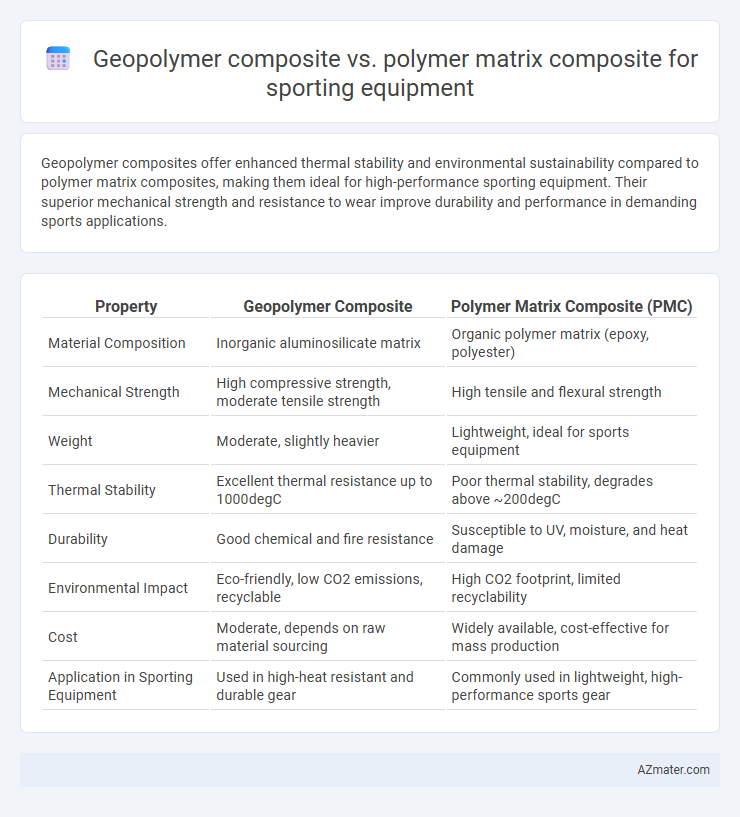Geopolymer composites offer enhanced thermal stability and environmental sustainability compared to polymer matrix composites, making them ideal for high-performance sporting equipment. Their superior mechanical strength and resistance to wear improve durability and performance in demanding sports applications.
Table of Comparison
| Property | Geopolymer Composite | Polymer Matrix Composite (PMC) |
|---|---|---|
| Material Composition | Inorganic aluminosilicate matrix | Organic polymer matrix (epoxy, polyester) |
| Mechanical Strength | High compressive strength, moderate tensile strength | High tensile and flexural strength |
| Weight | Moderate, slightly heavier | Lightweight, ideal for sports equipment |
| Thermal Stability | Excellent thermal resistance up to 1000degC | Poor thermal stability, degrades above ~200degC |
| Durability | Good chemical and fire resistance | Susceptible to UV, moisture, and heat damage |
| Environmental Impact | Eco-friendly, low CO2 emissions, recyclable | High CO2 footprint, limited recyclability |
| Cost | Moderate, depends on raw material sourcing | Widely available, cost-effective for mass production |
| Application in Sporting Equipment | Used in high-heat resistant and durable gear | Commonly used in lightweight, high-performance sports gear |
Introduction to Sporting Equipment Materials
Geopolymer composites offer enhanced thermal resistance, lightweight properties, and environmental sustainability compared to traditional polymer matrix composites commonly used in sporting equipment. Polymer matrix composites provide superior impact resistance, flexibility, and ease of manufacturing, making them ideal for high-performance applications like tennis rackets and bicycle frames. Recent innovations in geopolymer composites are expanding their use by combining durability and eco-friendly advantages in sports gear production.
Overview of Geopolymer Composites
Geopolymer composites are inorganic polymer-based materials formed by the reaction of aluminosilicate powders with alkaline activators, offering exceptional thermal stability, high mechanical strength, and resistance to chemical corrosion. Their lightweight nature combined with environmental sustainability makes them advantageous for sporting equipment that demands durability and performance under extreme conditions. Unlike traditional polymer matrix composites, geopolymer composites provide enhanced fire resistance and reduced environmental impact during production and disposal.
Overview of Polymer Matrix Composites
Polymer matrix composites (PMCs) are widely used in sporting equipment due to their high strength-to-weight ratio, excellent fatigue resistance, and design flexibility. These composites typically consist of a polymer resin matrix reinforced with fibers such as carbon, glass, or aramid, enabling optimized performance for applications like tennis rackets, golf clubs, and bicycle frames. The inherent durability and impact resistance of PMCs enhance athlete performance while maintaining lightweight characteristics essential for competitive sports.
Mechanical Properties Comparison
Geopolymer composites exhibit superior thermal stability and higher compressive strength compared to polymer matrix composites, making them ideal for high-impact sporting equipment. Polymer matrix composites offer greater tensile strength and flexibility, enhancing performance in dynamic sports applications requiring lightweight and durable materials. Mechanical properties such as fatigue resistance and stiffness also vary, with geopolymer composites excelling in rigidity while polymer matrix composites provide better energy absorption and resilience.
Weight and Density Considerations
Geopolymer composites exhibit higher density compared to polymer matrix composites, impacting overall weight in sporting equipment applications. Polymer matrix composites offer lightweight advantages due to lower density materials like carbon and glass fibers, enhancing athlete performance through improved agility and reduced fatigue. Weight reduction in polymer matrix composites is critical for sports gear design, where minimal mass correlates with faster response and better control.
Durability and Environmental Resistance
Geopolymer composites offer superior durability and environmental resistance compared to polymer matrix composites in sporting equipment, with enhanced thermal stability and resistance to UV radiation, moisture, and chemical degradation. Their inorganic matrix provides exceptional fire resistance and long-term mechanical integrity under harsh conditions, making them ideal for outdoor sports applications. Polymer matrix composites, while lightweight and versatile, often suffer from degradation due to prolonged exposure to sunlight, humidity, and temperature fluctuations, reducing their lifespan in demanding environments.
Manufacturing Processes and Scalability
Geopolymer composites employ inorganic aluminosilicate binders cured at moderate temperatures, offering eco-friendly manufacturing with lower carbon footprints compared to polymer matrix composites that rely on thermosetting or thermoplastic resins requiring energy-intensive curing processes. The scalable production of geopolymer composites is currently limited by longer curing times and sensitivity to environmental conditions, whereas polymer matrix composites benefit from established industrial processes like resin transfer molding and automated lay-up, enabling mass customization and high throughput. Technical challenges in controlling geopolymer chemistry and ensuring consistent mechanical properties present scalability barriers not as prevalent in polymer matrix composites used in sporting equipment manufacturing.
Sustainability and Eco-Friendly Aspects
Geopolymer composites offer superior sustainability compared to polymer matrix composites by utilizing industrial by-products such as fly ash and slag, significantly reducing carbon footprint and reliance on petrochemicals. Their inherent fire resistance, durability, and biodegradability contribute to eco-friendly sporting equipment design without compromising performance. Polymer matrix composites typically involve synthetic resins and non-recyclable fibers, leading to greater environmental impact during production and end-of-life disposal.
Performance Case Studies in Sports Applications
Geopolymer composites exhibit superior thermal stability and mechanical strength compared to polymer matrix composites, making them ideal for high-performance sporting equipment like tennis rackets and bicycles. Case studies reveal that geopolymer composites enhance shock absorption and durability under extreme conditions, contributing to improved athletic performance and equipment longevity. Polymer matrix composites, while lighter, often suffer from lower thermal resistance and wear, limiting their use in sports demanding high impact and temperature tolerance.
Future Trends in Composite Materials for Sports Equipment
Geopolymer composites exhibit superior thermal resistance and environmental sustainability compared to conventional polymer matrix composites, making them a promising option for future sports equipment manufacturing. Innovations in nanotechnology and bio-based additives are enhancing the mechanical properties and durability of both composite types, driving advancements in lightweight, high-performance gear. The increasing demand for eco-friendly materials and regulatory pressures are accelerating the adoption of geopolymer composites, positioning them as key players in next-generation sports equipment design.

Infographic: Geopolymer composite vs Polymer matrix composite for Sporting equipment
 azmater.com
azmater.com